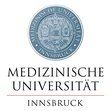Online Course
Neurobiology for non‑specialists
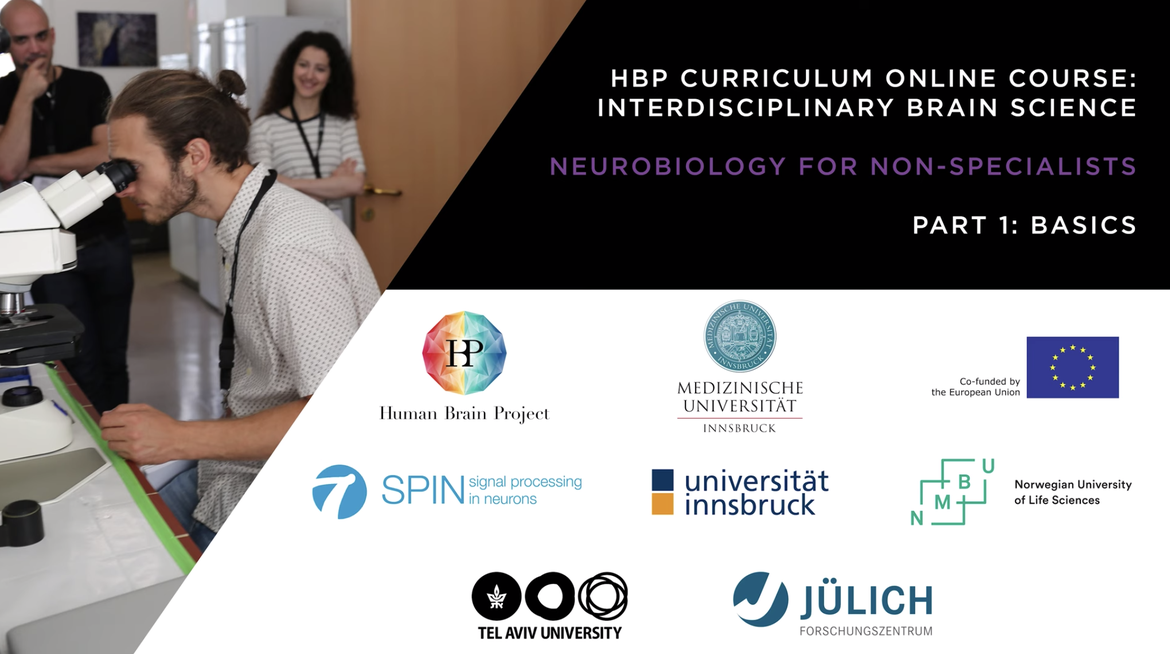
About
The field of neuroscience is one of the most interdisciplinary scientific fields. It is constantly expanded and developed further and unites researchers from a vast variety of backgrounds such as chemistry, biology, physics, medicine or psychology. By examining the principles that influence the development and function of the human nervous system, it advances the understanding of the fundamental mechanisms of human behaviour, emotions, and thoughts, and what happens if they fail. This course addresses the basic principles relevant for the performance and evolution of the nervous system and provides an overview for PhD students from a different area of specialisation. It further includes advanced lectures on more specific questions and challenges of the field.
ECTS credits: 1 (basics) + 1 (advanced) (after attendance of the online course, one full workshop and successfully passing the exam)
Lectures
Click here to access the basic lectures
Click here to access the advanced Lectures
Part 1: Basics
Lecture 1: Intercellular signal transduction
Christoph Schwarzer | MUI
Lecture 2: Intracellular signal transduction
Christoph Schwarzer | MUI
Lecture 3: Glial cells
Christine Bandtlow | MUI
Lecture 4: Myelination in the CNS and PNS
Christine Bandtlow | MUI
Lecture 5: Neuronal networks
Christoph Schwarzer | MUI
Lecture 6: Basic neuroanatomy
Lars Klimaschewski | MUI
Lecture 7: Nociceptors and perception of pain
Serena Quarta | MUI
Part 2: Advanced
Lecture 1: Neuroinflammation and demyelination
Markus Reindl | MUI
Lecture 2: Neurodegenerative diseases - En route to early detection and prevention
Nir Giladi | TAU
Lecture 3: Learning and memory: Basic concepts and medical implications
Nicolas Singewald | LFU
Lecture 4: Learning and memory: Underlying mechanisms and networks
Francesco Ferraguti | MUI
Lecture 5: Motivation and addiction: Neuronetworks and treatment targets
Gerald Zernig | MUI
Lecture 6: Computational neuroscience: Bridging brain scales with mathematics
Gaute Einevoll | NMBU
Lecture 7: The human brain atlas as a part of the HBP Neuroinformatics Platform
Timo Dickscheid | JUELICH
Lecture 8: Principles of neuropharmacology
Sandra Santos-Sierra | MUI
Speakers & Abstracts
Lecture title: Glial cells
Types of glial cells
Glial cells and homeostasis (influence of cerebral blood flow; influence on neurons)
Insulation and protection of axons (myelin sheath; nodes of Ranvier)
Microglia and reactions of the CNS to injury
Lecture title: Myelination in the CNS and PNS
Origin and differentiation of myelinating cell types
Molecular mechanisms defining onset and progression of myelination
Demyelination and remyelination after injury
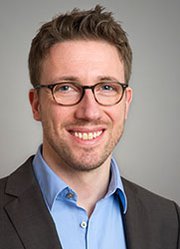 Timo Dickscheid is heading the "Big Data Analytics" group at the Institute of Neuroscience and Medicine (INM-1), Forschungszentrum Jülich, Germany. He graduated in Computer Science at the University of Koblenz and Landau in 2006, and earned his PhD at the University of Bonn in 2011 under the supervision of Prof. Wolfgang Förstner. In his thesis project, Dickscheid worked on methods for 3D reconstruction of building interiors from cameras, and developed a statistical framework for image feature matching with spatial constraints. In 2010, he joined Forschungszentrum Jülich as a post-doc in the lab of Katrin Amunts, where he worked on medical image registration and segmentation methods for building 3D human brain models. After accepting a position as the head of Information Technology at the German Federal Institute of Hydrology in Koblenz in 2012, Dickscheid returned to Jülich again in 2014. His research group focuses on high-resolution biomedical image analysis for building multilevel atlases of the human brain, and implements modern image processing and machine learning methods on high performance computing platforms for processing large datasets. In the Human Brain Project (HBP), Dickscheid adresses cross-cutting aspects between Neuroinformatics and High Performance Computing for human brain atlasing. Since 2016, Dickscheid is leading the work package 5.3 "Multi-level Atlas of the Human Brain" within HBP's Neuroinformatics Platform, as well as tasks in Subprojects 2 ("Human Brain Organization") and 7 ("High Performance Analytic and Computing Platform").
Timo Dickscheid is heading the "Big Data Analytics" group at the Institute of Neuroscience and Medicine (INM-1), Forschungszentrum Jülich, Germany. He graduated in Computer Science at the University of Koblenz and Landau in 2006, and earned his PhD at the University of Bonn in 2011 under the supervision of Prof. Wolfgang Förstner. In his thesis project, Dickscheid worked on methods for 3D reconstruction of building interiors from cameras, and developed a statistical framework for image feature matching with spatial constraints. In 2010, he joined Forschungszentrum Jülich as a post-doc in the lab of Katrin Amunts, where he worked on medical image registration and segmentation methods for building 3D human brain models. After accepting a position as the head of Information Technology at the German Federal Institute of Hydrology in Koblenz in 2012, Dickscheid returned to Jülich again in 2014. His research group focuses on high-resolution biomedical image analysis for building multilevel atlases of the human brain, and implements modern image processing and machine learning methods on high performance computing platforms for processing large datasets. In the Human Brain Project (HBP), Dickscheid adresses cross-cutting aspects between Neuroinformatics and High Performance Computing for human brain atlasing. Since 2016, Dickscheid is leading the work package 5.3 "Multi-level Atlas of the Human Brain" within HBP's Neuroinformatics Platform, as well as tasks in Subprojects 2 ("Human Brain Organization") and 7 ("High Performance Analytic and Computing Platform").
Lecture title: The human brain atlas as a part of the HBP Neuroinformatics Platform
As a part of its Neuroinformatics Platform, the Human Brain Project is developing a comprehensive multi-level Human Brain Atlas. The atlas consists of different web-based services that enable users to discover, explore and access a unique selection of anatomical reference spaces and high-quality structural parcellations. A diverse range of well curated human brain data at different scales and modalities will be made available, which are semantically linked and often spatially anchored to the reference spaces, together with tools for displaying and analyzing data. In this talk you will get an overview on human brain atlasing and human data at different spatial scales. You will see typical usecases of an atlas, find out why and how IT infrastructure is required to implement a modern atlas, and learn about the underlying methodologies that we need to relate data across scales, subjects and image modalities.
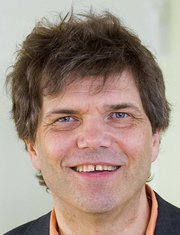 Gaute Einevoll is a Professor of physics at the Norwegian University of Life Sciences and University of Oslo. His main research interests are on biophysical modelling of electrical signals and various aspects of multiscale modeling of early sensory pathways, including how to connect models at different levels of detail, biophysical modeling of astrocytes and their interactions with neurons, as well as development of neuroinformatics tools. Einevoll received his master’s in physics from the Norwegian University of Science and Technology in Trondheim in 1985 and his doctoral degree in theoretical physics from the same university in 1991. He is a co-leader of the Norwegian national node of the International Neuroinformatics Coordinating Society (INCF). Einevoll is active in popularising science and has, for example, written two popular physics books.
Gaute Einevoll is a Professor of physics at the Norwegian University of Life Sciences and University of Oslo. His main research interests are on biophysical modelling of electrical signals and various aspects of multiscale modeling of early sensory pathways, including how to connect models at different levels of detail, biophysical modeling of astrocytes and their interactions with neurons, as well as development of neuroinformatics tools. Einevoll received his master’s in physics from the Norwegian University of Science and Technology in Trondheim in 1985 and his doctoral degree in theoretical physics from the same university in 1991. He is a co-leader of the Norwegian national node of the International Neuroinformatics Coordinating Society (INCF). Einevoll is active in popularising science and has, for example, written two popular physics books.
Lecture title: Computational neuroscience: Bridging brain scales with mathematics
A main challenge in brain science is the many scales involved, from the molecular scale to whole brains and behaviour. And these different scales are intimately connected. For example, a change in a molecule, such as a mutation in the DNA molecule, can have devastating effects for the entire animal or human. The lecture will outline how mathematics, and in particular an intimate 'two-handed' collaboration between experimentalists (‘one hand’) and modelers (‘the other hand’), can help bridge the scales in neuroscience and provide a more comprehensive understanding of brain function.
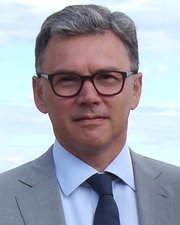 Francesco Ferraguti graduated in 1987 in Medicine at the University of Modena (Italy) where he also became a specialist registrar in Clinical Nutrition. After a short postgraduate training in the Dept. Histology and Neurobiology at the Karolinska Institutet (Sweden) with Prof. K. Fuxe and then in the Dept. Human Physiology at the University of Modena with Prof. L. Agnati, he joined in 1991 the Glaxo Medicines Research Centre in Verona (Italy) as a research scientist. From 1993-97 Prof. Ferraguti headed the Mol. Pharmacol. Laboratory of the Dept. Pharmacology at the Verona Glaxo Medicines Research Centre. In 1998, he moved to the Dept. Pathology of the University of Cambridge (U.K.) as a Senior Research Associate and in 2000 to the MRC Anatomical Neuropharmacology Unit-Dept. Pharmacology, University of Oxford, (U.K.) as band 3 Scientist working with Prof. P. Somogyi. He received a call from the Medical University of Innsbruck (Austria) in 2003 first as an Assistant Prof. and then as Prof. for Neuropharmacology at Dept. Pharmacology. Since 1st October 2011, he became director of the Dept. Pharmacology of the Medical University of Innsbruck.
Francesco Ferraguti graduated in 1987 in Medicine at the University of Modena (Italy) where he also became a specialist registrar in Clinical Nutrition. After a short postgraduate training in the Dept. Histology and Neurobiology at the Karolinska Institutet (Sweden) with Prof. K. Fuxe and then in the Dept. Human Physiology at the University of Modena with Prof. L. Agnati, he joined in 1991 the Glaxo Medicines Research Centre in Verona (Italy) as a research scientist. From 1993-97 Prof. Ferraguti headed the Mol. Pharmacol. Laboratory of the Dept. Pharmacology at the Verona Glaxo Medicines Research Centre. In 1998, he moved to the Dept. Pathology of the University of Cambridge (U.K.) as a Senior Research Associate and in 2000 to the MRC Anatomical Neuropharmacology Unit-Dept. Pharmacology, University of Oxford, (U.K.) as band 3 Scientist working with Prof. P. Somogyi. He received a call from the Medical University of Innsbruck (Austria) in 2003 first as an Assistant Prof. and then as Prof. for Neuropharmacology at Dept. Pharmacology. Since 1st October 2011, he became director of the Dept. Pharmacology of the Medical University of Innsbruck.
Lecture title: Learning and memory: Underlying mechanisms and networks
This lecture will focus on our current neurobiological understanding of learning and memory. Decades of research have led to the development of several general basic principles underlying learning and memory and the identification of different memory systems. In this lecture, some of the paradigms that have been used to study simple forms of explicit and implict memory will first be described. Later, the neurobiological mechanisms underlying short- and long-term forms of learning and memory, which involve structural and functional changes in existing neural circuits, will be discussed.
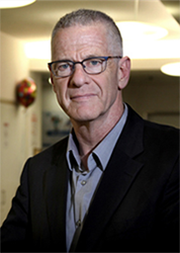 Nir Giladi is a neurologist, expert in movement disorders with many years of experience treating patients with Parkinson’s disease. Currently he is the chairman of the department of Neurology at TASMC and as such have access to a large patient pool as well as all needed facilities and infrastructure to assist in this proposed research. For more than 20 years he is involved in research in PD with great interest in clinical management, gait and movement disorders, genetic aspects of PD, epidemiological studies and neuroimaging. In the past decade he managed, overlooked and carried out numerous clinical trials involving patients with PD with expertise in all medical, clinical and applicative aspects. Nir Giladi believe this innovative application has the ability to enhance patient well-being and quality of life. He has the expertise, leadership, motivation and am well positioned to collaborate on and contribute to this study.
Nir Giladi is a neurologist, expert in movement disorders with many years of experience treating patients with Parkinson’s disease. Currently he is the chairman of the department of Neurology at TASMC and as such have access to a large patient pool as well as all needed facilities and infrastructure to assist in this proposed research. For more than 20 years he is involved in research in PD with great interest in clinical management, gait and movement disorders, genetic aspects of PD, epidemiological studies and neuroimaging. In the past decade he managed, overlooked and carried out numerous clinical trials involving patients with PD with expertise in all medical, clinical and applicative aspects. Nir Giladi believe this innovative application has the ability to enhance patient well-being and quality of life. He has the expertise, leadership, motivation and am well positioned to collaborate on and contribute to this study.
Lecture title: Neurodegenerative diseases - En route to early detection and prevention
Neurodegeneration is becoming the number one problem of healthcare and health policy in today's world. It is currently the main cause of dementia, parkinsonism and behavioral changes of the second half of life. The dramatic increase in longevity is doubling the number of people with dementia and behavioral problems, as well as the number of people suffering from motor disturbances and falls. With neurodegeneration becoming a modern epidemic, it is necessary not only to treat symptoms, but also to prevent Alzheimer's disease, Parkinson's disease, ALS, Huntington's disease and other neurodegenerative disorders. Modern understanding of neurodegenerative brain disorders associates mis-folded protein aggregations with the primary pathological process. Protein aggregations that start either within the brain or in the peripheral autonomic nervous system spread slowly, over a period of 1-3 decades, to neighboring structures. After many years they reach a critical degree of brain degeneration that causes mild symptoms of cognitive decline and movement disorders. Only then the clinical diagnosis is made and symptomatic therapy is initiated. Recent research has detected many biological markers that reflect the sub-clinical neurodegenerative process in its prodromal phase. This ability to detect the early stages of neurodegeneration enables us to better characterize populations at risk. It has brought up for the first time, the possibility of prevention of Alzheimer's disease or Parkinson's disease, or even Huntington's disease and ALS. New therapeutic strategies are already in phase 2 and 3 of clinical trials using monoclonal antibodies, small molecules or anti-sense technology, in order to slow down or even stop the progression of those devastating brain disorders. The future is already here and it is bringing with it hope to millions of patients and their family members, as well as to society as a whole.
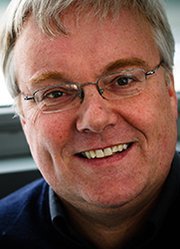 Lars Peter Klimaschewski was born in Germany 1965 and graduated as MD from the University of Hamburg in 1991. He received the PhD (Habilitation) in Anatomy and Cell Biology from the University of Heidelberg in 1997. Following a postdoctoral fellowship at the Department of Pathology (Center for Neuroscience), Columbia University, New York, he became Professor for Neuroanatomy at the University of Innsbruck, Austria, in 1999. He was appointed ERASMUS coordinator of the Medical University Innsbruck (2002-2008), Austrian representative of COST action B30 (2006-2010), member of the board of the Anatomical Society (2014-2018), head of the Division of Histology & Embryology (since 2015), director of the Department of Anatomy, Histology & Embryology (2016-2019), and guest professor in Belgium (University of Antwerp), China (Capital University Beijing), Czech Republic (University of Brno), Serbia (University of Belgrade) and Spain (University of the Basque Country).
Lars Peter Klimaschewski was born in Germany 1965 and graduated as MD from the University of Hamburg in 1991. He received the PhD (Habilitation) in Anatomy and Cell Biology from the University of Heidelberg in 1997. Following a postdoctoral fellowship at the Department of Pathology (Center for Neuroscience), Columbia University, New York, he became Professor for Neuroanatomy at the University of Innsbruck, Austria, in 1999. He was appointed ERASMUS coordinator of the Medical University Innsbruck (2002-2008), Austrian representative of COST action B30 (2006-2010), member of the board of the Anatomical Society (2014-2018), head of the Division of Histology & Embryology (since 2015), director of the Department of Anatomy, Histology & Embryology (2016-2019), and guest professor in Belgium (University of Antwerp), China (Capital University Beijing), Czech Republic (University of Brno), Serbia (University of Belgrade) and Spain (University of the Basque Country).
Lecture title: Basic neuroanatomy
In this basic neuroanatomy tutorial for non-specialists, I will introduce the principal anatomical organization of neural systems in the human brain and spinal cord that mediate sensation, integrate signals and motivate behavior. Starting with a short summary of brain development, I will discuss the spinal cord followed by a description of the surface anatomy of the brainstem including the cerebellum. Then, internal structures of the forebrain will be presented including the basal ganglia and the limbic system. The tutorial concludes with a survey of the cerebral hemispheres and summarizes quantitative histological data underlying cortical computation in different species.
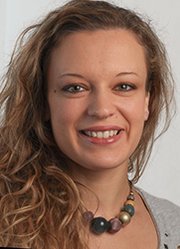 Serena Quarta is currently working as a post-doc researcher in the laboratory of Prof. Michaela Kress in the Department of Physiology and Medical Physics at the Medical University of Innsbruck, Austria, where she is a full time member of the academic staff. She received her Bachelor’s degree in Biotechnology in 2005 (summa cum laude) and an MSc degree in Molecular Biotechnology in 2007 (summa cum laude) from the University of Turin. She obtained her PhD in Neuroscience/Human Medicine from the Medical University of Innsbruck in 2013 (sehr gut/1), for which she was awarded with the Wilhelm-Auerswald-Prize from Bayer® for the best doctoral thesis within Austrian medical universities. Her scientific training started when she joined the group of Professor Carola Ponzetto at the University of Turin (Italy) in 2004-2005, during which she contributed in the characterization of an inducible TPR-MET driven melanoma model and in the study of the role of PAX3-FKHR in cellular differentiation and transformation. In 2005 she continued her training under the supervision of Professor Ferdinando Di Cunto at the MBC, Molecular Biotechnology Center, in Turin/Italy, where she was involved in a 2 years project investigating the role of TTC3, a new uncharacterized protein. During her PhD she was a member of the DK SPIN international PhD program under the supervision of Professor Michaela Kress. Specifically, she worked on a project regarding the role of the IL-6 signal transducer gp130 in pain under pathological conditions. She continued her research at the Medical University of Innsbruck as a post-doc investigating the action of cytokines, sphingolipids and metalloproteinases in neuropathic pain and peripheral nerve regeneration. In 2015 she was awarded the MUI-start grant. She has published several papers in international peer reviewed journals, she is on the reviewer board of several scientific journals and a member of the Austrian Neuroscience Association (ANA), the Society for Neuroscience (SfN), the International Brain Research Organization (IBRO) and the International Association for the Study of Pain (IASP). She is involved in teaching duties for undergraduate and master students at the Medical University of Innsbruck and the organization of public events, such as the Brain Awareness Week. Her interests revolve mainly around understanding the outgrowth processes of neuronal cells and how to improve neuronal regeneration after injury.
Serena Quarta is currently working as a post-doc researcher in the laboratory of Prof. Michaela Kress in the Department of Physiology and Medical Physics at the Medical University of Innsbruck, Austria, where she is a full time member of the academic staff. She received her Bachelor’s degree in Biotechnology in 2005 (summa cum laude) and an MSc degree in Molecular Biotechnology in 2007 (summa cum laude) from the University of Turin. She obtained her PhD in Neuroscience/Human Medicine from the Medical University of Innsbruck in 2013 (sehr gut/1), for which she was awarded with the Wilhelm-Auerswald-Prize from Bayer® for the best doctoral thesis within Austrian medical universities. Her scientific training started when she joined the group of Professor Carola Ponzetto at the University of Turin (Italy) in 2004-2005, during which she contributed in the characterization of an inducible TPR-MET driven melanoma model and in the study of the role of PAX3-FKHR in cellular differentiation and transformation. In 2005 she continued her training under the supervision of Professor Ferdinando Di Cunto at the MBC, Molecular Biotechnology Center, in Turin/Italy, where she was involved in a 2 years project investigating the role of TTC3, a new uncharacterized protein. During her PhD she was a member of the DK SPIN international PhD program under the supervision of Professor Michaela Kress. Specifically, she worked on a project regarding the role of the IL-6 signal transducer gp130 in pain under pathological conditions. She continued her research at the Medical University of Innsbruck as a post-doc investigating the action of cytokines, sphingolipids and metalloproteinases in neuropathic pain and peripheral nerve regeneration. In 2015 she was awarded the MUI-start grant. She has published several papers in international peer reviewed journals, she is on the reviewer board of several scientific journals and a member of the Austrian Neuroscience Association (ANA), the Society for Neuroscience (SfN), the International Brain Research Organization (IBRO) and the International Association for the Study of Pain (IASP). She is involved in teaching duties for undergraduate and master students at the Medical University of Innsbruck and the organization of public events, such as the Brain Awareness Week. Her interests revolve mainly around understanding the outgrowth processes of neuronal cells and how to improve neuronal regeneration after injury.
Lecture title: Nociceptors and perception of pain
The lecture is focused on the comprehension of nociception and pain sensation. It will highlight the principles of nociception, how the somatosensory system and different molecular partners are involved in nociception. The lecture will also explore how nociception and pain sensation are studied in rodents and humans and the development of pain therapy. Specific topics which the lecture covers are:
- Nociception vs. pain
- How nociception works and how a nociceptor is defined
- Characteristics of nerve fibers and dorsal root ganglia
- How to test nociception: Methods available for rodents and humans
- Types of pain and pain models
- Pain pathways and important molecular partners (neurotransmitters, cytokines, growth factors and channels)
- Specific pain syndromes and pain therapy
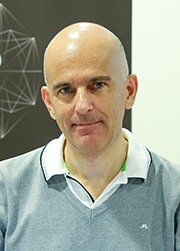 Markus Reindl is Associate Professor for Neuroscience at Medical University of Innsbruck and heads the Neurological Research Laboratory at the Clinical Department of Neurology. The main research focus of Markus Reindl in the past 20 years was the role of human autoantibodies directed against different central nervous system tissue antigens, mainly myelin oligodendrocyte glycoprotein and aquaporin-4 in demyelinating diseases such as multiple sclerosis and neuromyelitis optica. His laboratory has established cell-based immunoassays for the detection of these antibodies, which have been used for numerous clinical, immunological and epidemiological studies.
Markus Reindl is Associate Professor for Neuroscience at Medical University of Innsbruck and heads the Neurological Research Laboratory at the Clinical Department of Neurology. The main research focus of Markus Reindl in the past 20 years was the role of human autoantibodies directed against different central nervous system tissue antigens, mainly myelin oligodendrocyte glycoprotein and aquaporin-4 in demyelinating diseases such as multiple sclerosis and neuromyelitis optica. His laboratory has established cell-based immunoassays for the detection of these antibodies, which have been used for numerous clinical, immunological and epidemiological studies.
Lecture title: Neuroinflammation and demyelination
The first part of this lecture gives an overview on immune reactions in the nervous system and the blood brain barrier. In the second part of this lecture the pathophysiology of demyelinating diseases and the relevance of neuroinflammation will be presented.
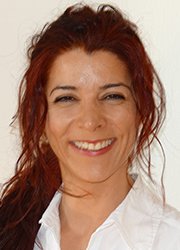 Sandra Santos Sierra graduated in Chemistry (Complutense University, Madrid, Spain) and obtained a Ph.D. in Molecular Biology (Center for Biological Sciences, CSIC, Madrid). She did her postdoctoral studies at the Children´s Hospital in the University of Freiburg (Germany) and since then she works in the field of Innate Immunity. In the Medical University of Innsbruck, her research focuses in the discovering of compounds which modulate the activity of Toll-like receptors (TLRs) and also in understanding how the TLR-downstream signaling is impacted in disease.
Sandra Santos Sierra graduated in Chemistry (Complutense University, Madrid, Spain) and obtained a Ph.D. in Molecular Biology (Center for Biological Sciences, CSIC, Madrid). She did her postdoctoral studies at the Children´s Hospital in the University of Freiburg (Germany) and since then she works in the field of Innate Immunity. In the Medical University of Innsbruck, her research focuses in the discovering of compounds which modulate the activity of Toll-like receptors (TLRs) and also in understanding how the TLR-downstream signaling is impacted in disease.
Lecture title: Principles of neuropharmacology
During my presentation we will get an overview of some essential concepts in Neuropharmacology (e.g. receptor binding, agonism, antagonism). We will also get an introduction in Pharmacodynamics and Pharmacokinetics and finally an overview of the drug discovery process relative to diseases of the Central Nervous System.
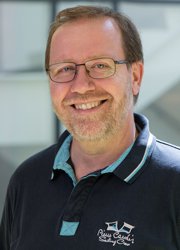 Christoph Schwarzer is a microbiologist and biochemist by training. After his PhD he switched to neuropharmacology, combining molecular biology with animal behavior to investigate epilepsy. At present he is heading a research group at the Dept. Pharmacology at the Medical University of Innsbruck, which is part of the doctoral college SPIN (signal processing in neurons), an excellence initiative funded by the Austrian Science Fund. Their main research interest focuses on the functional implications of the endogenous opioid system in physiology and pathophysiology of the brain. Investigating both, the influence of opioids on behavior as well as the functional implication of opioids in epilepsy is crucial to develop novel, efficient, yet save therapies. At present they follow two main lines, one refers to the development of novel classes of drugs with functional selectivity (biased drugs), the other to the development of gene therapy for epilepsy.
Christoph Schwarzer is a microbiologist and biochemist by training. After his PhD he switched to neuropharmacology, combining molecular biology with animal behavior to investigate epilepsy. At present he is heading a research group at the Dept. Pharmacology at the Medical University of Innsbruck, which is part of the doctoral college SPIN (signal processing in neurons), an excellence initiative funded by the Austrian Science Fund. Their main research interest focuses on the functional implications of the endogenous opioid system in physiology and pathophysiology of the brain. Investigating both, the influence of opioids on behavior as well as the functional implication of opioids in epilepsy is crucial to develop novel, efficient, yet save therapies. At present they follow two main lines, one refers to the development of novel classes of drugs with functional selectivity (biased drugs), the other to the development of gene therapy for epilepsy.
Lecture title: Intercellular signal transduction
- Basic structure of a cell/neuron
- Basic principles of synaptic transmission
- Structure and function of the synapse
- Ion channel receptors.
Lecture title: Intracellular signal transduction
- Types of receptors and signalling mechanisms
- Signalling cascades
- Signalling to the nucleus
Lecture title: Neuronal networks
- Integrating information within a network
- Modulating and controlling networks
- Functions and dysfunction of the hippocampal network
- The integrative network controlling sleep and arousal
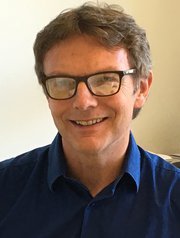 Nicolas Singewald is Professor for Pharmacology and heads the Neuropharmacology Unit at the Department of Pharmacology and Toxicology, University of Innsbruck, Austria. He studied pharmacy and received his Ph.D. from the Institute of Pharmaceutical Chemistry, University of Innsbruck, Austria. He did his post-doctoral work at the Department of Pharmacodynamics in Innsbruck studying central cardiovascular regulation. In 1996 he became Associate Professor at the Department of Pharmacology and Toxicology. He spent 1998 and 1999 as a Erwin Schrödinger Fellow (FWF) at the University of Oxford, UK, Department of Clinical Pharmacology working on anxiety pharmacology. From 1999-2001 he was Interimistic Director of the Department of Pharmacology and Toxicology in Innsbruck. Since 2002 he is Head of the Neuropharmacology Unit in this department. Prof. Singewalds current research interests include cognitive enhancement, the investigation of neurobiological mechanisms and neurocircuitries important in stress, anxiety, depression, as well as psychopharmacotherapeutic treatment of psychiatric disorders.
Nicolas Singewald is Professor for Pharmacology and heads the Neuropharmacology Unit at the Department of Pharmacology and Toxicology, University of Innsbruck, Austria. He studied pharmacy and received his Ph.D. from the Institute of Pharmaceutical Chemistry, University of Innsbruck, Austria. He did his post-doctoral work at the Department of Pharmacodynamics in Innsbruck studying central cardiovascular regulation. In 1996 he became Associate Professor at the Department of Pharmacology and Toxicology. He spent 1998 and 1999 as a Erwin Schrödinger Fellow (FWF) at the University of Oxford, UK, Department of Clinical Pharmacology working on anxiety pharmacology. From 1999-2001 he was Interimistic Director of the Department of Pharmacology and Toxicology in Innsbruck. Since 2002 he is Head of the Neuropharmacology Unit in this department. Prof. Singewalds current research interests include cognitive enhancement, the investigation of neurobiological mechanisms and neurocircuitries important in stress, anxiety, depression, as well as psychopharmacotherapeutic treatment of psychiatric disorders.
Lecture title: Learning and memory: Basic concepts and medical implications
In this lecture, we begin with defining learning and memory. Important memory processes, including attention, encoding, consolidation, storage, retrieval and forgetting will be considered. Different types of memory stores will be introduced and discussed, as well as the value of animal models of learning and memory for cognitive neuroscience. General methods to enhance memory, followed by the current status in the development of novel therapeutic strategies for cognitive impairments, e.g. cognitive enhancers, will be highlighted. Finally, important memory disorders will be discussed.
Gerald Zernig has a wide-ranging research interest in motivation and dependence syndromes. He received his MD from the University of Graz, Austria, in 1984, and pursued a career as a pharmacologist and experimental cardiologist before turning to mental disorders as his primary research interest. He spent 3 years in the laboratory of Dr James H Woods at the University of Ann Arbor, Michigan, USA, and 1 year in the lab of Dr H Chris Fibiger at the University of British Columbia, Vancouver, Canada. Dr Zernig is a trained and certified psychotherapist in private practice and has continuously served over several decades as an expert court witness in substance-related cases. He is particularly interest in the neuronetworks mediating the reorientation of an individual away from the drug of abuse toward social interaction.
Lecture title: Motivation and addiction: Neuronetworks and treatment targets
Most psychiatric disorders (most notably dependence syndromes, depression, psychosis, and autism) are characterized by impaired social interaction, with many patients preferring a drug of abuse. Dr Zernig will present and discuss the latest research on the neural basis of normal and impaired social interaction and of the therapeutically highly beneficial reorientation away from cocaine as a typical drug of abuse toward other individuals and society.
Course Directors
Alois Saria, Christoph Schwarzer | Medical University Innsbruck
